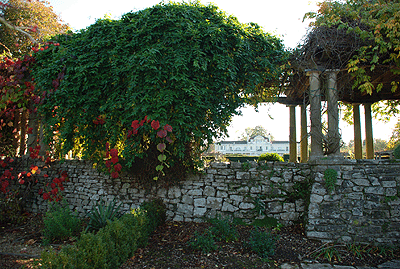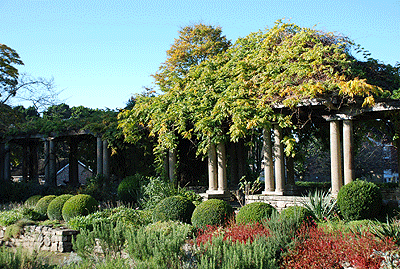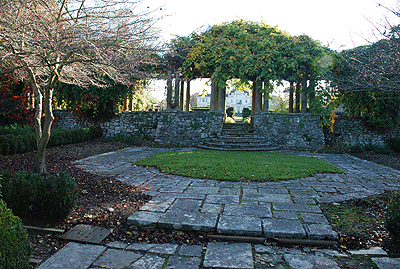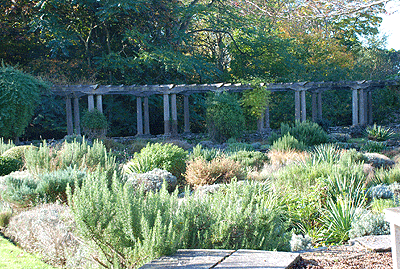Perils and pleasures of a period garden – part II
Francoise talks us through the second part of her blog on restoring and or renovating period gardens, and how to take on larger projects

In part one of our ‘Perils and Pleasures of a Period Garden' we looked at the research needed for either restoration or renovation of a period garden before taking spade to soil. Now we look at the nitty gritty of building and planting the garden.
* Missed part I? Read the first part of our heritage gardens blog
Armed with all the vital information on its history, the designer and their design you are ready to undertake the build phase of the garden and the layout for the planting.
If the research has unearthed patios, pergolas, ponds, terraces and other such features, these will need to be re-built if you are doing a faithful restoration - that is to say to bring about the reinstatement of a garden exactly as it was, supported by available drawings and plans, to a time-line that you have chosen.
If you are re-constructing the garden based on architectural evidence but where no plans or very little information exists of the original design, then you need to take decisions on how you want to use the garden, how you want it to look and how you are going to adapt it to the lifestyle you lead.
In both situations a large scale project would really benefit from professional design and management. This is not something that should be undertaken lightly as the whole endeavour could become extremely costly. A professional designer will be able to source the right materials, advise on the latest construction techniques, ensure the design is faithful and interpreted correctly for the 21st century and hire the right team to build the garden. In all cases project management is fundamental as overruns are hugely costly in both time and money.
An interesting case study is the sunken garden and pergola at Townhill Park, Southampton which had lain in ruins since 1997. The rebuild of the whole garden was mostly funded by the sale of cakes (at open days), which explains why it took so many years to get it to the state it is in now! The dry walling and pergola materials were difficult to source and much of the rubble was re-used. New materials were incorporated into the build, unfortunately not always very successfully.
Exquisite houses, the beauty of Nature, and how to get the most from your life, straight to your inbox.

Old, original materials are not always easy to find, but architectural salvage and reclamation yards are a great place to start looking. From bricks to statuary, these can be the best source of reclaimed materials. Try MASCo Architectural Salvage http://www.mascosalvage.com/ based in Stroud and Bath, or consult the Salvo website http://salvo.co.uk/ which is the directory for all reclamation companies in the UK. If using new materials is the only option aim to source material which has the best likeness to the original in terms of colour, texture and how it will weather over the years (if you have that information to hand). If in doubt consult your research and primary and secondary drawings, or pictures of materials of the time.

Things do not get easier when it comes to planting. A restoration implies that the original planting plans will be used and that the plants used will be the varieties stated on those plans. If your garden is older than the 1940s it may be difficult at times to source these old varieties as many have been replaced. If your garden dates back to the 18th Century it will be near impossible to find such plants. Most plants grown were from seeds passed on from generation to generation or locally traded at the time. The commercial seed trade did not take off until the 19th century and many of these were from the New World. Such a boom created some rather fanciful planting designs and did not take into account the often arduous maintenance regimes required. People with gardens in past centuries were often well off and thus had the means to hire an army of gardeners to ensure everything looked pristine at all times.

The best course of action for sourcing heritage varieties of plants is to consult heirloom plant and seed nurseries. A Google search should yield some results but not all your planting will be available, and compromises will have to be made. A close match to the variety you are looking for, or close to in characteristics are the next best thing.

If you garden is a re-construction and you want adapt it for the 21st century then you have a rather freer rein. New varieties are often disease resistant and adapted to a changing climate. This means that you can choose the best plants for your soil, for your garden and for the way you live in your garden. Again, a garden designer can design a planting plan which will look like the original, or of the period, but plant it with very 21st century plants that will require as little or as much maintenance as you want.

If your garden is listed, you will need to work with English Heritage and they will advise on the best course of action in regards to the hard landscaping as well as the planting.
If you are interested in the history of the house and the garden at Townhill Park, Rosaleen Wilkinson, a volunteer who helped restore the gardens, has written a book - ‘Townhill Park, The life and Times of a Gertrude Jekyll Garden'. Available from the author on 023-8078 1012 she charts the history of the Montagu family and the long process of restoring and re-building a period garden.
Whether you have found a Gertrude Jekyll under your lawn or just want to re-create a period garden, remember to do all the research at the beginning as this will help you in scheduling the works. A garden historian or archaeologist is recommended if you believe you have a significant historical gem under that lawn. Lastly, period garden restoration and re-construction is not for the faint hearted but can be a most rewarding project. Just make sure the budget and your patience goes beyond installing a lawn!
Open day for Townhill Park Monday 3rd May 2010 (Bank Holiday) 2pm-5pm and Sunday 11th July 2010 2pm-5pm
* Francoise Murat, who shot the photographs for this article, runs Francoise Murat & Associates, a registered business in ProjectBook.co.uk's Heritage Register. Francoise is running a course: ‘Owning a period garden' on 15th April 2010. Further details can be found in the ProjectBook events section.
* For more on period buildings and gardens, and how to take care of them, visit www.projectbook.co.uk where you can find the Heritage Register - a service helping period property owners to locate vetted craftsmen, contractors and consultants, along with a comprehensive range of specialist resources relevant to historic properties.
Country Life is unlike any other magazine: the only glossy weekly on the newsstand and the only magazine that has been guest-edited by His Majesty The King not once, but twice. It is a celebration of modern rural life and all its diverse joys and pleasures — that was first published in Queen Victoria's Diamond Jubilee year. Our eclectic mixture of witty and informative content — from the most up-to-date property news and commentary and a coveted glimpse inside some of the UK's best houses and gardens, to gardening, the arts and interior design, written by experts in their field — still cannot be found in print or online, anywhere else.
